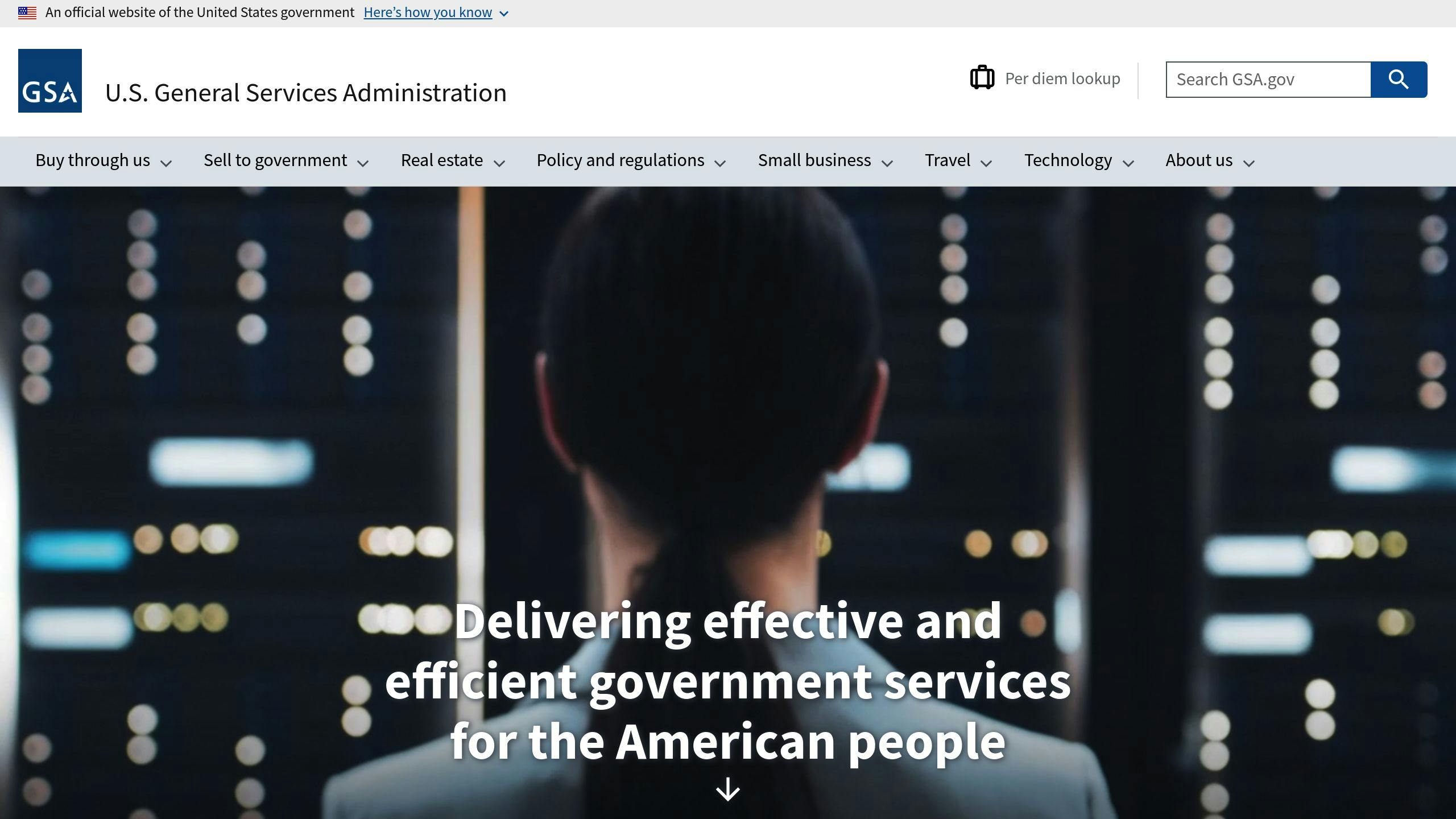GSA pricing audits in 2025 come with stricter rules and a focus on compliance. If you’re a contractor, here’s what matters most:
- Key Changes: New Economic Price Adjustment (EPA) framework, stricter Price Reductions Clause (PRC) monitoring, and mandatory transactional data accuracy.
- Audit Focus Areas: CSP disclosures, price reductions, and market price comparisons.
- Documentation Requirements: Accurate sales records, pricing history, and compliance reports are essential.
- Digital Tools: Use compliance software and electronic recordkeeping to stay organized and audit-ready.
Why It Matters: Non-compliance can lead to financial setbacks like refunds or reduced GSA pricing. Proactive preparation is critical to staying competitive and avoiding penalties.
Start by reviewing your pricing practices, updating documentation, and adopting digital tools to simplify compliance.
Mastering the Art of GSA Schedule Contract Management
Table of Contents
Toggle
2025 GSA Pricing Audit Changes
The GSA has introduced updates to its pricing audit procedures for 2025, aiming to simplify processes while upholding strict compliance standards.
EPA Clause Updates
The GSA has merged multiple Economic Price Adjustment (EPA) clauses into a single framework [5]. This new structure allows contractors and Contracting Officers more flexibility in handling price adjustments. With this change, the focus now shifts to ensuring the accuracy of transactional data.
Transactional Data Requirements
For 2025, the GSA places a strong emphasis on accurate transactional data, requiring contractors to keep detailed sales records [1][3]. Key expectations include:
- Tracking all Schedule transactions consistently
- Keeping thorough documentation of pricing changes and verifying data with internal systems
- Reconciling sales reports every quarter
These measures aim to ensure that reported data is precise and reliable.
Market Price Comparison Standards
To promote fair pricing, the GSA has refined its market analysis approach [2]. Contractors are now required to:
- Compare GSA Schedule prices with commercial market rates
- Justify their pricing strategies
- Prove competitiveness in the federal marketplace
Supporting documentation such as market research, price history, cost analysis, and commercial sales data must be maintained to back up pricing decisions. These updates are designed to ensure transparency and fair pricing practices.
Main Pricing Audit Focus Areas
The GSA’s 2025 audits, shaped by recent regulatory updates, focus on three critical areas of pricing compliance.
CSP Disclosure Requirements
Commercial Sales Practices (CSP) disclosures remain a key part of GSA pricing compliance. Contractors must ensure their CSP-1 documents are accurate, clearly outline pricing methods, and stay updated when pricing practices change. They should also be ready to explain any pricing differences across various customer groups.
"The combination of CSP and Price Reduction requirements will keep pricing low across the GSA Schedule market but will also ensure that the Government receives the best pricing that the contractor can offer." – Coley GCS Advisors [2]
Price Reduction Rules
Monitoring under the Price Reductions Clause (PRC) has tightened in 2025. Contractors need to carefully track their Basis of Award (BOA) customer relationships. For instance, if a contractor provides a larger discount to their BOA customer, they must adjust the GSA price accordingly to maintain the agreed discount relationship.
Any price reductions impacting this relationship must be reported to the Contracting Officer within 15 days [3]. This rule ensures that GSA pricing remains aligned with BOA agreements.
Common Documentation Issues
Documentation errors are a recurring theme in audits. Recent GSA audit findings highlight two main challenges:
- Incomplete Transaction Records: Missing details like pricing history, discount justifications, and market research data are common mistakes.
- Poor Record Management: Contractors often fail to maintain adequate evidence of compliance, such as missing pricing justifications or incomplete sales data.
Improving documentation processes is essential. Using digital tools can help contractors stay organized and meet compliance standards more efficiently.
sbb-itb-8737801
Digital Tools in GSA Audits
Digital tools are now central to managing GSA audits, reshaping how contractors handle their Schedule contracts and stay compliant.
Price Compliance Software
Price compliance software has become a key resource for GSA contractors. Here’s what it offers:
| Feature | Purpose | Advantage |
|---|---|---|
| Price Analytics | Tracks pricing and identifies trends across sales channels | Helps avoid compliance issues |
| System Integration | Connects to existing accounting systems | Ensures accurate data |
| Compliance Reports | Produces audit-ready documentation | Eases audit preparation |
GSA’s Data Analysis Approach
The GSA uses advanced data analysis techniques to conduct detailed audits. These methods include:
- Identifying pricing irregularities through pattern recognition
- Comparing prices with market standards using algorithms
- Ensuring compliance with Trade Agreements Act (TAA) regulations
- Monitoring transactions for inconsistencies
These automated tools help pinpoint pricing issues and other compliance risks efficiently.
Digital Record Management
Proper electronic record management is crucial for successful audits. Here’s what contractors need to focus on:
1. Securing Records
- Store records in encrypted, cloud-based solutions for security and accessibility.
- Set up strict access controls to protect sensitive data.
- Keep all relevant records for at least three years after final payment.
2. Organizing and Updating Files
- Use clear and consistent naming conventions for all documents.
- Separate files into folders for pricing history, transactions, and compliance.
- Conduct quarterly reviews to ensure all documentation is up to date.
These digital tools tackle common audit challenges like pricing errors and missing records [6]. By adopting robust systems, contractors can handle audits more effectively while staying aligned with GSA requirements. Plus, they make audit preparation much more manageable.
2025 Audit Preparation Steps
As GSA ramps up its pricing oversight in 2025, being ready for audits has never been more important. Here’s a simple guide to help you stay prepared and organized.
Key Documentation and Review Steps
| Document Type | Purpose | Retention Period |
|---|---|---|
| Sales Records | Track transactions and pricing history | 3 years after final payment |
| Price Lists | Document commercial pricing structure | Current + previous versions |
| Contract Modifications | Record approved GSA changes | Full contract duration |
| CSP Disclosures | Detail commercial sales practices | Most recent submission |
| Price Reduction Documentation | Track PRC compliance | Full contract duration |
To stay ahead of audits, focus on these practices:
-
Regular Data Reviews
- Compare GSA and commercial customer pricing every quarter.
- Check monthly sales data for accuracy, including IFF (Industrial Funding Fee) calculations.
- Keep thorough records of any pricing deviations.
-
Compliance Monitoring
- Stay on top of Price Reduction Clause (PRC) obligations.
- Ensure all required documents are up-to-date.
- Review transaction records to confirm completeness.
"Regular documentation reviews are key to avoiding compliance risks during GSA audits" [2][3].
How GSA Focus Can Help

Audit preparation can get complicated fast, which is why many businesses turn to specialists like GSA Focus. Their services simplify the process by offering:
- Professional management of documentation and compliance.
- Expert advice to guide you through audit preparation.
- Representation during audit discussions.
- Implementation of efficient record-keeping systems.
With GSA audits expected to increase in 2025 [1], having expert support can make a big difference. GSA Focus helps reduce administrative headaches while ensuring your business stays compliant with the latest requirements. If you’re looking for additional help, their services can save time, improve compliance, and make audit preparation much smoother.
Conclusion: Next Steps for GSA Pricing Audits
Main Changes Summary
GSA pricing audits in 2025 come with updated compliance requirements, making it essential for contractors to adapt. Here’s a quick look at the key updates:
| Audit Area | 2025 Updates |
|---|---|
| EPA Clauses | New rules for price adjustments and ceiling rate limits |
| Documentation | Tougher standards for CSP disclosures and monitoring price reductions |
These updates highlight the need for contractors to stay ahead to avoid penalties and maintain compliance.
Action Steps for Businesses
"Although the compliance review and historical pricing analysis can be time consuming, the effort pales in comparison to management’s distraction and the potential financial impact of an adverse audit report from the GSA OIG" [2].
To tackle the challenges of stricter audits, contractors should focus on these critical areas:
-
Detailed Records Management:
Keep accurate historical pricing records, use digital tools to track adjustments, and ensure disclosures are always up-to-date [4]. -
Strengthened System Controls:
Regularly test compliance controls, document them thoroughly, and consistently monitor pricing adjustments [1].
For those needing help, GSA Focus offers services to streamline compliance management. Their expertise in document preparation and audit readiness can be a game-changer, especially with the increased complexity of 2025 requirements.
"GSA audits can be tricky, but careful attention to the government’s requests and adherence to best practices can help your company successfully navigate its way through" [4].
Ignoring compliance risks can lead to financial setbacks like refunds for overcharges or reduced ceiling prices [4]. By addressing these priorities, contractors can strengthen their position in the federal market and reduce audit-related risks.
Related Blog Posts
- GSA Price List Update Success Stories
- How Value-Based Pricing Impacts GSA Contracts
- How to Track GSA Contract Compliance
- Top 5 Compliance Issues in GSA Contracts


